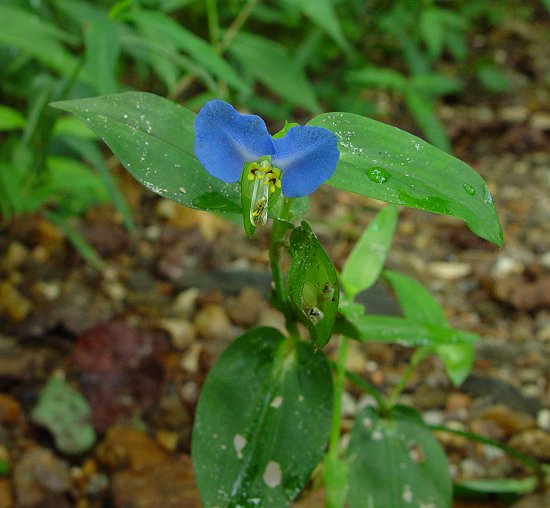Commelina communis L.
Common Dayflower

Introduced
CC = *
CW = 0
MOC = 55
© DETenaglia
Commelina communis L.Common Dayflower | |
 |
Introduced CC = * CW = 0 MOC = 55 |
© DETenaglia |
|
Family - Commelinaceae Habit - Annual forb with slender, fibrous roots. Stems - Erect to ascending or decumbent with age, to 80 cm, internodes glabrous, somewhat pubescent and often rooting at nodes. Leaves - Alternate, entire, typically glabrous to minutely scabrous above, glaucous below. Base of blade forming a sheath around stem. Sheaths mostly 1-2 cm long, glabrous or ciliate with white hairs near the tips.
Inflorescence - Inflorescences axillary, mostly stalked, the flowers emerging from folded bract (spathe). Spathelike bracts 12-30 mm long, the margins free to the base, the lower edge (midrib of the bract) straight or nearly so.
Flowers - Sepals 3-4 mm long. Petals 3, strongly unequal, the upper 2 petals 8-16 mm long, blue, the lower petal 3-5 mm long, white. Fertile stamens 3. Staminodes 3, with well-developed false anthers, these mostly 4-lobed, yellow, usually with a reddish brown spot at the center.
Fruits - Capsules 6-7 mm long, 2-locular and 4-seeded. Seeds 2.5-3.5 mm long, the surface with a usually strongly developed pattern of reticulate, polygonal ridges.
Flowering - May - October. Habitat - Banks of streams and ditches, moist roadsides, lawns, disturbed sites, railroads. Origin - Native to Asia. Lookalikes - Other members of the genus, especially Commelina erect. Other info. - This plant is scattered to common throughout Missouri. Distribution maps suggest that it is probably more common than the native species (C. erecta) in the northern half of the state but less common in the southern half. Its larger range includes the eastern half of the continental U.S. and Canada. As a group, dayflowers are easily recognized by the "Mickey mouse morphology" of their flowers, with two large, blue upper petals like cartoon mouse ears. One of the native dayflowers, C. erecta, looks virtually identical except for the appearance of the folded bract enclosing the inflorescence. In the native species this is partially fused, with a visible elbow in the curve of the bract. In C. communis it is open to the base and smoothly curved (see photos above). Photographs taken in Vale, NC., 8-23-03 (DETenaglia); also at Busch Wildlife Area, St. Charles County, MO, 8-30-2008, Weldon Spring Conservation Area, St. Charles County, MO, 8-16-2011, and along the Duckett-Busch greenway, St. Charles County, MO, 9-25-2017 (SRTurner). |